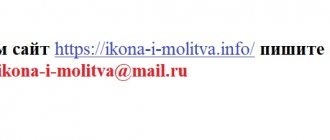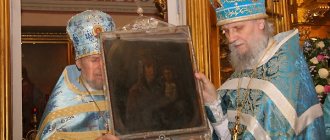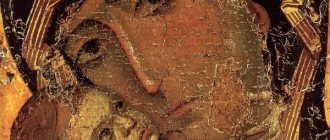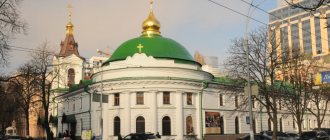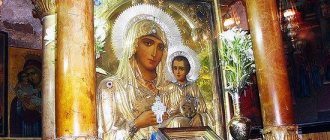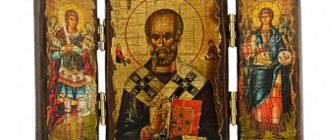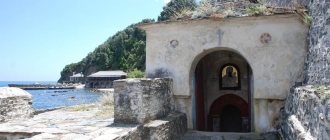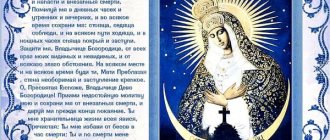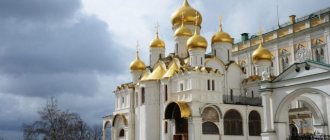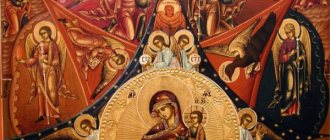One of the most revered among Orthodox and Roman Catholics is the Czestochowa Icon of the Mother of God. Both the Orthodox and Catholic worlds pray before her. Her image is honored on March 6 by Christians in Eastern Europe, while Catholics commemorate her on August 26. In addition, the image of the Virgin Mary has many other names that are no less famous. These include the names Mother of God of Czestochowa, “Jasnogorskaya”, “Black Madonna” - since the icon has darkened with age. The Czestochowa Icon of the Mother of God in Poland is called the Czestochowa Matka Boska, but in short prayer songs it is called “Invincible Victory.”
The icon of the Mother of God of Czestochowa has truly ancient roots. History attributes this icon to the works of the prophet Luke, of which there are 70 in total. For a long time, the image of the Mother of God remained in the Byzantine Empire, then it was transported to Galician Rus', from where, after Poland conquered Western Ukraine, the icon of the Invincible Victory passed to the Poles. Today it is located in the Sanctuary of the Blessed Virgin Mary of Jasnogorsk, in a Catholic monastery in the city of Czestochowa.
History of the image
According to legend, the Icon of the Mother of God of Czestochowa was painted by the Apostle Luke from the Virgin Mary during her lifetime. All the icons he painted were kept in Jerusalem in the house of John the Theologian, since the Mother of God herself lived there, and after her death they were revered as shrines.
When the Jews, before the arrival of Roman troops, went to the mountains, they took all the images with them for their safety. This board was taken to the city of Pelle and was kept there in the mountains until the 4th century. All this time she took part in divine services and was known to believers.
Icon of the Blessed Virgin Mary “Czestochowa”
When Queen Helena arrived in Jerusalem in 326 (she also found the Cross of the Lord), Christians brought and presented her with a wonderful image of the Virgin Mary. Helena brought it to Constantinople, where she placed it in the palace chapel and where she came to worship. The icon remained there for five centuries.
As for the appearance of the image on Russian soil, there is no consensus. There are different theories:
- According to one of them, the image was brought to Rus' by Saints Cyril and Methodius from Constantinople. The icon became a blessing to them in educational matters.
- According to the second version, the icon was brought to Rus' by the Greek princess Anna, who married the prince of Kievan Rus - Vladimir. The board was given to her as a blessing in a foreign land and as a wedding gift. According to legend, this is how the icon ended up in the city of Belz, in a church chapel. Although the opinions of historians differ on whether it was a wedding gift to Anna and Vladimir or another princely couple, because then it was the norm to marry Orthodox princesses and bring them to Russian soil.
- The third version says that the shrine was brought to the city of Belz by Prince Lev from Constantinople as a war trophy.
The shrine remained in Belz until 1377, as a legacy to the local princes. After the shrine ended up in Kievan Rus, it traveled a long way to its current location. The icon went to the Polish prince Wladyslaw of Opolsky after the conquest of Western Ukraine, and he brought it to Poland in 1382.
When he was transporting the icon to Poland, the prince stopped overnight in the village of Częstochowa, and the image was placed in the parish church on Jasna Gora. When the prince decided to move on, they could not move the icon from its place. So she chose her place of stay and Vladimir left her there. Nowadays there is a monastery in that place, where the shrine is kept today.
The pilgrimage to the shrine began after Queen Jadwiga arrived at Jasna Gora. Most of all, Russians from Galicia came to the monastery, who considered it theirs (it was there that the plaque was kept before Vladimir took it). Almost all the kings of Poland and Lithuania came to her.
The icon was seriously damaged during the Czech invasion, when the monastery was dilapidated and all documents were burned. The image itself was cracked and had to be sent to Poland to be glued together. To protect the holy place, King Sigismund III erected a fortification around the Czestochowa Monastery and turned it into a fortress. And later a large church was erected there.
About other venerated images of the Mother of God:
- "Deliverer of Troubles"
- "Iverskaya"
- "Jerusalem"
Siege by the Swedes
In the 15th century, a new cathedral was built at the monastery, and in the 17th century, to protect the monastery from attacks that did not stop all this time, a powerful wall was built, turning Jasna Gora into a real fortress.
The formed fortifications turned out to be very useful. They were soon put to the test. This happened during the so-called Swedish Flood - the invasion of the Swedes into the territory of the Polish-Lithuanian Commonwealth, which occurred in 1655-1660.
The offensive developed so quickly and successfully for the attacking side that within a few months Warsaw, Poznan and Krakow were captured. Polish aristocrats en masse went over to the side of the enemy, which significantly weakened the position of the king and his entourage. Soon Jan Casimir fled the country altogether.
Already in November 1655, the Swedish army, led by General Miller, found itself at the walls of Jasnaya Gora. The Swedes' superiority in manpower was manifold at that time. The number of the Scandinavian army was about three thousand people. At this time, only 170 soldiers, 70 monks and 20 nobles remained in the monastery itself. Despite this, the abbot of the monastery, Augustin Kordetsky, decided to hold the line and fight to the last.
The heroic defense of the monastery became one of the glorious pages of Polish history, becoming a worthy example for the rest of the country. It is possible that it was then that Polish statehood was saved. The course of the military confrontation was turned around, which ultimately led to the expulsion of the Swedes from Poland. This was regarded by many as a miracle performed by the Mother of God.
King Jan Casimir, after returning to his country, made “Lviv vows”, choosing the Virgin Mary in a solemn ceremony as the patroness of the entire kingdom.
Miracles
The icon is known for its miracles. Thus, the scars on the cheeks of the Virgin Mary also testify to the miracle that happened to the image. In the Middle Ages, the monastery where the image was kept was attacked by Hussite troops. They robbed temples and killed monks. In the monastery, they collected a whole cart of valuables and planned to take them out to sell. However, when the driver began to steer the horses, the cart did not move, despite all the horse’s efforts.
One of the bandits, who had heard about the wonderful icon, jumped up to it and struck it with a saber. He immediately fell dead for his blasphemy. All the other robbers left the monastery in fear, without taking anything. Since then, there have been two deep cuts on the face of the Great Intercessor, as evidence of that miracle and as a reminder to evil people of the impending punishment.
When the monastery suffered from a serious fire, the image was covered with soot and fumes, and it was taken to Krakow for restoration. The artists, after cleaning the painting, decided to cover up the scars on the cheeks of the Virgin Mary, but were never able to do this. It was then that the Mother of God acquired some Gothic features that confuse parishioners today, because the image became very similar to the Gothic one that is common in Catholicism.
In the winter of 2001, in the Nicholas Monastery, copies of the Czestochowa icons began to stream myrrh, and later, some copies of the images that were kept by the parishioners of the church at home.
Icon of the Mother of God of Częstochowa
The rescue
The Czestochowa Icon of the Mother of God was saved from complete destruction. At the court of the Polish king Władysław Jagiello in Krakow, a restoration was carried out.
At that time, the techniques were still imperfect. Therefore, although the icon was able to be put together, the scars from the saber strikes after some time again appeared through the fresh paint on the face of the Virgin Mary. She was returned to the monastery.
In 1466, the monastery was again besieged. This time the Czech army tried to capture it, but to no avail.
Meaning and lists
The board is written in the Hodegetria style - the Virgin Mary is presented as a Guide to Christ. The following details are quite expressive in this image:
- Christ is seated on the Mother's hand;
- Jesus is clothed in royal robes, which indicates His Essence as a King;
- the Mother's left hand is directed directly at Christ, as if indicating to people who the Lord is;
- The Virgin Mary is depicted only from the waist up;
- on Her cheeks there are scars from saber blows;
- Christ's right hand is raised in blessing;
- in his left hand Jesus holds the Book, as a symbol of the fullness of His knowledge.
The board is small in size - 1222x822x35 mm. It was painted in the Byzantine style, although it also contains features of Western icon painting:
- clothing colors;
- lilies of gold on vestments;
- soft facial features (Russian icon painters usually toughen them).
In Russia there are several lists of the miraculous board:
- Czestochowa-Sokolska;
- icon “Softening Evil Hearts”;
- Lyubechskaya;
- Ozeryanskaya;
- Rudnenskaya;
- Brailovskaya;
- Dubovichskaya;
- Mokhnatinskaya.
For reference! In total, there are more than 11 exact lists and more than 20 prototypes copied from the icon of the Mother of God of Czestochowa.
Symbol of the fall of the Iron Curtain
The icon came into the spotlight in 1991. It was then that celebrations dedicated to World Youth Day took place in Częstochowa, Poland.
Pope John Paul II took part in them. On this occasion, a mass pilgrimage was organized to the icon. In total, about one million people took part in it. Among them were many young people from the Soviet Union.
This event became a vivid and symbolic evidence of the fall of the Iron Curtain.
What to pray to the image for
Today the holy image is kept in the Svyatogorsk Monastery in the Chapel of the Virgin Mary. This building is a small chapel made of wood, which was built in 1384. Later, the building was reconstructed into a three-nave chapel, and the icon itself, placed on an ebony iconostasis, was framed in a silver frame. To protect the precious shrine, it is covered with a special silver screen when there is no liturgy.
You won’t be able to venerate the image, since it is located quite high, but you can always pray to the Mother of God in front of it.
Pilgrims to Jasna Gora saw with their own eyes many miracles that happened to those who sincerely believed and prayed to the Virgin for help. Many left the crutches they came on, others later brought pendants as gratitude for healing from serious illnesses. There is evidence of healing from cancer, drug addiction and alcoholism.
Prayer to the miraculous icon
What should we pray for in front of the holy image? People usually ask:
- about a favorable path;
- about healing;
- about peace in the family and mutual understanding;
- about protection from envious people and enemies;
- about peace in the country;
- about wisdom and mercy towards people;
- about mercy from the Lord;
- about saving your soul and the souls of your loved ones.
Important!
The main thing is to remember that the Lord hears and answers all prayers. Let it not always be the way we want it to be. But His hand did not shrink from the believers, and we have the boldness to ask Him for mercy and help. You just need to remember that you need to ask for what will be useful for the soul, and not just for the flesh.
More about prayers to the Mother of God:
- Prayer for Marriage
- Prayer for children
- Prayers for health
Napoleonic Wars
In 1813, the monastery was captured by Russian troops during the Napoleonic Wars. After defeat in the Patriotic War of 1812, the French army rapidly retreated, surrendering previously captured positions.
The abbot of the monastery, grateful to the Russian army for the liberation, presented the military leaders with a list of the icon. It was brought to Russia and was kept for a long time in the Kazan Cathedral in St. Petersburg.
When the communists came to power, the cathedral was closed. Since 1932, the list has been moved to the State Museum of the History of Religion.
Prayer text
Oh, All-Merciful Lady, Queen Theotokos, chosen from all generations and blessed by all generations, heavenly and earthly! Look mercifully at these people standing before Your holy icon, earnestly praying to You and act by Your intercession and intercession with Your Son and our God, so that no one will depart from the place this hope of his is empty and he is ashamed in his hope; but let everyone receive from You everything according to the good intention of his heart, according to his need and desire, for the salvation of the soul and the health of the body. Pray, Merciful Lady, the most heavenly God, may he always preserve his holy church, strengthen our Orthodox bishops with his highest blessing, protect him in peace and protect his holiness The word of truth grants whole, healthy, honest, long-living and rightly ruling churches, from all visible and invisible He will mercifully deliver the enemies of all Orthodox Christians and will unfalteringly and unfailingly preserve them in Orthodoxy and the firm faith until the end of the ages. Look with mercy, O All-Singing One, and look upon Your merciful intercession for our entire All-Russian kingdom, our reigning cities, this city and this holy temple, and pour it on her Your rich mercy, You are the all-powerful Helper and Intercessor of us all. Bow down to the prayers of all Your servants who flow here to this holy icon of Yours, hear the sighs and voices with which Your servants pray in this holy temple. If both a non-believer and a foreigner, walking and passing here, pray, hear, O child-loving Lady, and do this love for mankind and mercifully, even to help him and to salvation. Guide the hardened and scattered hearts in our countries on the path of truth. Those who have fallen away from the pious faith, turn back and reconnect with Your saints in the Orthodox Catholic Church. In the families of all people and in our brethren, protect and maintain peace, establish brotherhood and humility in the young, support old age, instruct adolescence, make courage wise, protect orphans and widows and bring comfort and protection to the oppressed and in sorrow, bring up babies, heal the sick, captives Free us, protecting us from all evil with Your goodness and comforting us with Your merciful visit and all those who do us good. Grant, O Good One, fruitfulness to the earth, prosperity to the air, and all the gifts that are timely and useful for our benefit, through your omnipotent intercession before the All-Holy Life-Giving Trinity, together with the holy chosen saints of Her, Cyril and Methodius. Fathers and mothers who have gone before, our brothers and sisters, and all who have fallen from the ancient years to Thy holy icon, this resting place is in the villages of the saints, in a place of light, in a place of evil Rather, in a place of peace, where there is no sorrow and sighing. When our departure from this life and transmigration to eternal life arrives, appear to us, O Most Blessed Virgin, and grant the Christian death of our life painless, shameless, to us I will partake of the Lord and the Holy Mysteries, and in the future we will all be considered worthy, together with all the saints, endless blessed life in the kingdom of Your beloved Son, our Lord and Savior Jesus Christ, to Him belongs all glory, honor and worship forever and ever. Amen.
